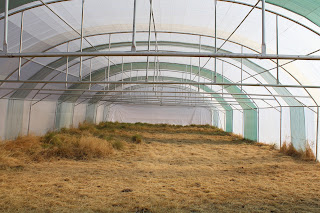 Generally Indigenous Knowledge Systems (IKS) has a low profile in the country, which makes the “Indigenous medicinal plants” chapter quite a task every time we update the Agri Handbook! Imagine our delight to find out that Byron and Soozi are medicinal plants experts!
Generally Indigenous Knowledge Systems (IKS) has a low profile in the country, which makes the “Indigenous medicinal plants” chapter quite a task every time we update the Agri Handbook! Imagine our delight to find out that Byron and Soozi are medicinal plants experts!A medicinal plants centre is planned here. Why not? Many of the most useful indigenous plants, they tell us, grow within a thirty km radius of Rustler’s. Indigenous knowledge will be championed, says Byron, and a conversation built around it. Not only African but knowledge from around the world that fits this category.
A medicinal plant conservatory project will include the Traditional Healers Association, homeopaths and relevant parties. It will have educational and conservation purposes, tying in with what Rustler’s is all about. Travel and tourism is involved, planting days, harvesting days which employ people in the district, and tapping into the herbal market.
Plans for the nursery include fruit trees (trees can reverse climate change). Soozi points to where old cherry trees stand. She speaks of planting new trees between the older ones, giving the older ones a parent function. As we walk, van der Linde points to the swales on the farm, ridges constructed to retain water after rain. She speaks of other potentials on the farm: rainwater harvesting, the use of grey water for use in toilets. There are plans to have a borehole (indeed, Gino had excused himself from events this day to meet to borehole-related visitor).
 |
| Approaching the Healing Centre |
 |
| Building rondavels at the Healing Centre |
 |
| ... and ablution blocks |
Soozi picks up on the permaculture credentials, potentials, of the place. Permaculture founder, Bill Morrison, gave his first training in this country here at Rustler’s Valley. Under the old owner, gardening was done for individual homesteads though; it was not a common (what today’s is).
She points to the rows of bluegums and speaks of the protection they provide for crops from the wind. Fire and water are the two major threats on the farm. To safeguard the farm, use is made of winter (to clear waterways) and summer (to ensure measures to deal with fire).
She points to the aloes, planted to keep soil in place. They have a flat root system and are ideal for this function. Aloes grow on the steep side of mountains; humans can copy the principle in using them. In addition to being a permaculturist and medicinal plant expert, Soozi champions biomimicry too.
Soozie is also qualified and registered as a carbon-footprints analyst, and ponders the implications of vehicles arriving/leaving Rustler’s, the mechanisation, livestock, the lifestyle. It is important to plant trees to offset carbon. Carbon is a waste product and I am not surprised to find that waste management is among her skills.
We are headed back for to the reception and our vehicles.





No comments:
Post a Comment